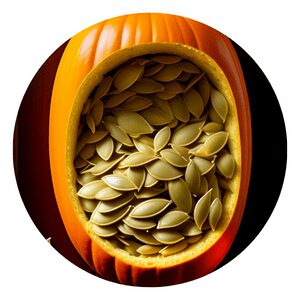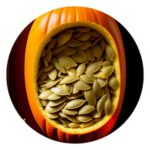How Do You Grow Organic Pumpkin From Seeds?
Organic gardening is gaining popularity for being an environmentally friendly and healthy way to grow plants.
Growing organic pumpkins from seed is a great way to enjoy the fruits of your labor in a natural and sustainable way.
If you’ve ever wanted to learn how to grow pumpkin from seeds, this article can help you out.

Table of Contents
Growing organic pumpkins
Organic pumpkins are a popular choice for both cooking and decoration.
As their popularity increases, so does the importance of growing them from seeds.
Growing organic pumpkins from seed ensures that you have healthy, natural produce that has not been exposed to any potentially harmful chemicals.
Not only can this result in healthier food for your family and friends, but it can also provide a fun and rewarding experience for anyone looking to get back in touch with nature.
Organically grown pumpkins can be used for delicious seasonal recipes such as pies or soups as well as being a great addition to seasonal decorations around the home.
All you need is some organic pumpkin seeds, soil, compost and plenty of sunshine!
The process of growing organic pumpkins requires minimal effort yet yields maximum results; however there are certain tips and tricks to ensure optimal growth.
Steps to Growing Organic Pumpkin from Seeds
Growing organic pumpkin from seeds is a great way to enjoy the amazing flavor and nutrition of homegrown pumpkins.
Whether you’re growing pumpkins for Halloween decorations, to make delicious pies or just for fun, there are some important steps that you’ll need to take in order to ensure your organic pumpkin patch will be successful.
Here are some tips on how do you grow organic pumpkin from seeds:
Selecting the right seeds
When growing pumpkins organically, it’s important to select the right varieties that are well-suited for organic growing conditions.
Here are some factors to consider when choosing pumpkin varieties:
Disease resistance: Look for varieties that are resistant to common pumpkin diseases such as powdery mildew and mosaic virus.
Maturity time: Choose pumpkin varieties with a maturity time that is appropriate for your growing season.
Early maturing varieties are best for shorter growing seasons, while later maturing varieties are better for longer growing seasons.
Growing conditions: Consider the growing conditions of your garden, including soil type, sunlight, and temperature.
Some pumpkin varieties are more tolerant of different growing conditions than others.
Purpose: Consider why you want to grow pumpkins.
For example, if you want to make pumpkin pie, you may want to choose a variety that is sweeter and has less water content.
Space: Some pumpkin varieties can grow to be very large and take up a lot of space.
Make sure to choose a variety that is appropriate for the size of your garden.
By carefully selecting the right pumpkin varieties for your organic growing conditions, you can ensure a successful harvest.
Preparing soil for planting
When it comes to growing organic pumpkins from seeds, the most important step is preparing your soil.
With the right conditions, you can create a nutrient-rich environment that will help your pumpkin plants thrive.
Before planting, you’ll want to loosen and aerate the soil with a shovel or spade.
This will make it easier for roots to penetrate and allow for good drainage of water and nutrients.
Compost or manure can be added to increase the organic matter in your soil; this will help support healthy plant growth and prevent nutrient loss over time.
If your soil doesn’t have enough humus or potassium, consider adding natural fertilizers such as bone meal or rock dust before planting your pumpkin seeds.
Once you’ve created an optimal growing condition in the soil, it’s time to plant!
A pumpkin found all covered in mud, A seed brought it to life with a thud, Now organic and brightly abloom, It shines like the light of the moon. Plant it in loam that’s rich deep down, Along come the birds who sing their sweet sound, Days pass and strength fills its stem, Stands proud as harvest season begins. When autumn chill grows strong and bold, Gather round for stories of old, Carry the sound of this sweet surprise - Organic pumpkins we grew from just one little seed!
Chappy The Gardener
Sowing the seeds
Place the pumpkin seeds into small holes that are approximately 1 inch deep into the prepared soil and be sure to keep them evenly spaced apart before lightly covering them with more soil or mulch.
Transplanting seedlings
Transplanting seedlings is an essential step in growing organic pumpkins from seeds. It allows the plants to reach their full potential and produce a healthy crop of pumpkins.
Transplanting is best done when the seedlings have at least three pairs of true leaves, which typically happens around 4-6 weeks after planting the seeds. This ensures adequate time for root development before transplanting.
When transplanting, gardeners should dig a hole that is twice as wide and deep as the container holding the seedling.
The soil should be mixed with compost to provide additional nutrients for maximum growth.
The seedling should be carefully removed from its container and placed into the soil so that its roots are surrounded by loose soil, not too tightly packed or compressed.
Watering and fertilizing
Watering should begin once the germination process has been completed.
However, it’s important to check soil moisture levels with a finger test before adding more water.
The soil should feel damp but not overly saturated; if necessary, gently water the pumpkin plants in areas where some additional moisture is needed.
Fertilizing can begin when plants have produced several sets of leaves.
To give your pumpkins a boost of nutrients, use an organic fertilizer that’s high in nitrogen such as liquid fish emulsion or compost tea.
A few tablespoons per gallon of water should be sufficient for each application, applied every couple weeks throughout the growing season.
Proper spacing and trellising
Organic pumpkin growing is a great way to enjoy the harvest season in style!
Proper spacing and trellising are important components of organic gardening that can help you maximize the outcome of your effort.
When planting seeds, it’s best to space them out accordingly – at least three feet apart – as they need plenty of room to spread their roots and grow strong.
Along with giving them enough room, trellising or staking your pumpkins is recommended for better support from wind and other elements.
You can purchase specially designed trellises for your pumpkin plants or simply use bamboo poles placed around the plant for added stability.
Additionally, using a thick layer of mulch will help retain moisture, reduce weeds, and keep temperatures slightly cooler which can be beneficial to your pumpkin’s growth.
Dealing with pests and diseases
Growing pumpkins organically involves using natural methods to control pests and diseases, rather than relying on chemical pesticides and fungicides.
Here are some tips for dealing with pests and diseases in an organic pumpkin garden:
Crop rotation: Planting pumpkins in a different location each year can reduce the buildup of pests and diseases in the soil.
Companion planting: Certain plants, such as marigolds and nasturtiums, can help repel pests and improve soil health.
Physical barriers: Use floating row covers to protect seedlings and young plants from insect pests, or place physical barriers such as mesh screens or sticky tape around the base of the plant to deter crawling pests.
Handpicking: Inspect your plants regularly and remove any pests by hand. This is especially effective for controlling small infestations of caterpillars, aphids, and other insects.
Natural predators: Encourage beneficial insects, such as ladybugs and lacewings, that feed on common pumpkin pests by planting a variety of flowering plants in your garden.
Diatomaceous earth: This natural powder made from crushed fossils can be sprinkled around the base of the plant to control soft-bodied pests like slugs and aphids.
Neem oil: This natural insecticide made from the neem tree can be used to control a wide range of pests, including aphids, whiteflies, and spider mites.
To control diseases, it’s important to:
Practice good garden hygiene: Remove any diseased leaves or plants from the garden and dispose of them properly.
Water wisely: Water the plants at the base, avoiding getting the leaves wet, to reduce the spread of fungal diseases.
Provide adequate air circulation: Thin out overcrowded plants and make sure there is enough space between plants for air to circulate.
Avoid overhead irrigation: Watering from above can spread fungal spores and increase the risk of disease.
By using these organic methods, you can help keep pests and diseases under control and protect the health and quality of your pumpkin crop.
Harvesting and storing the pumpkins
Harvesting and storing pumpkins grown organically is an important step to ensure that your pumpkins are in good condition for use.
Here are some tips for harvesting and storing pumpkins:
Timing: Harvest pumpkins when they are fully mature, usually when the skin is tough and the stem is dry.
To determine if a pumpkin is ready, gently press your thumbnail into the skin – if it doesn’t easily puncture, the pumpkin is ready to be harvested.
Cutting: Use a sharp knife or garden shears to cut the stem of the pumpkin, leaving a 1-2 inch stem attached.
This will help prevent rot and extend the shelf life of the pumpkin.
Curing: Place the harvested pumpkins in a warm, dry area for about 10 days to cure.
This will help harden the skin and improve storage life.
Cleaning: Gently wipe the pumpkins with a damp cloth to remove any dirt or debris, but avoid getting the skin wet.
Storing: Store pumpkins in a cool, dry, and well-ventilated area, such as a garage or basement, away from direct sunlight.
Avoid stacking pumpkins directly on top of each other, as this can cause bruising and rot.
Monitoring: Check your pumpkins regularly for signs of decay or disease and remove any damaged pumpkins promptly to prevent the spread of decay to healthy pumpkins.
By following these steps, you can ensure that your organically grown pumpkins are stored properly and have a long shelf life.
Whether you plan to use them for decoration, cooking, or carving, your pumpkins will be ready when you need them.
Tips for Success
Organic pumpkin growing is an incredibly rewarding experience that can be enjoyed by gardeners of all levels.
With the right preparation and tips, it’s easy to successfully grow and harvest a bumper crop of organic pumpkins.
Here are some top tips for success when it comes to organic pumpkin cultivation:
Choosing a suitable location
Growing organic pumpkin from seeds is a rewarding experience that anyone can enjoy.
But before you get started, it’s important to choose the right location for your plants.
An ideal spot should provide plenty of sun, have well-drained soil and be free from any potential pests or diseases.
Your chosen location should receive at least 6 hours of sunlight each day, and preferably 8 or more hours if available.
The soil should be fertile with good drainage and no standing water after rainstorms.
If you don’t have access to ideal soil in your chosen area, then fertilizers and compost can help improve the quality of the soil for better growth.
Additionally, it’s best to pick a spot away from other plants so as to avoid any potential contamination or spread of disease between them.
Using organic methods for pest control
Organic pest control methods are effective and environmentally friendly ways to keep pests under control in your pumpkin garden.
Here are some organic methods for pest control:
Crop rotation: Planting pumpkins in a different location each year can reduce the buildup of pests and diseases in the soil.
Companion planting: Certain plants, such as marigolds and nasturtiums, can help repel pests and improve soil health.
Physical barriers: Use floating row covers to protect seedlings and young plants from insect pests, or place physical barriers such as mesh screens or sticky tape around the base of the plant to deter crawling pests.
Hand picking: Inspect your plants regularly and remove any pests by hand.
This is especially effective for controlling small infestations of caterpillars, aphids, and other insects.
Natural predators: Encourage beneficial insects, such as ladybugs and lacewings, that feed on common pumpkin pests by planting a variety of flowering plants in your garden.
Diatomaceous earth: This natural powder made from crushed fossils can be sprinkled around the base of the plant to control soft-bodied pests like slugs and aphids.
Neem oil: This natural insecticide made from the neem tree can be used to control a wide range of pests, including aphids, whiteflies, and spider mites.
By using these organic methods, you can help keep pests under control in your pumpkin garden and maintain a healthy and sustainable growing environment for your plants.
It’s important to remember that organic pest control methods may require more time and patience than chemical methods, but the long-term benefits to your health, the environment, and the quality of your pumpkin crop make it well worth the effort.
Maintaining healthy soil
Organic pumpkin is a popular vegetable for many gardeners.
It’s not just delicious in pies, but growing organic pumpkin from seeds can also be rewarding and good for the environment.
To have successful growth, it’s important to maintain healthy soil.
Healthy soil helps the plant roots to absorb nutrients needed for healthier plants and higher yields of organic pumpkin.
This means that you should make sure your soil contains plenty of nitrogen, phosphorus, potassium and other essential nutrients.
Organic matter such as compost or mulch can also assist in improving soil quality and provide an effective way to keep your plants nourished throughout the season.
To get the most out of your soil when planting organic pumpkins from seed, test it regularly during each stage of growth – this will help you identify any deficiencies that need addressing with appropriate fertilisers or amendments before planting time arrives.
Properly caring for the plants throughout the growing season
Organic gardening has become increasingly popular in recent years as more and more people are interested in growing their own food.
Pumpkins, a favorite vegetable for many, can be grown organically from seeds.
From selecting good quality seed to determining when it is time to harvest, there are several steps involved when growing organic pumpkins.
You will want to select pumpkin varieties that do well in your climate or region and that have been certified as organic if you wish to stick with an entirely organic method of cultivation.
In conclusion, growing organic pumpkin from seeds can be a rewarding and fun experience.
You will know your pumpkins are free of pesticides, fungicides, and other chemicals that could harm you or the environment.
Plus, it’s a great activity to do with children or friends.
Once you get the hang of it, you’ll be amazed at what you can grow in your garden.
Finally, don’t forget about pumpkin recipes!
Click To Grow
Helps Us Grow – Share If You Like
















